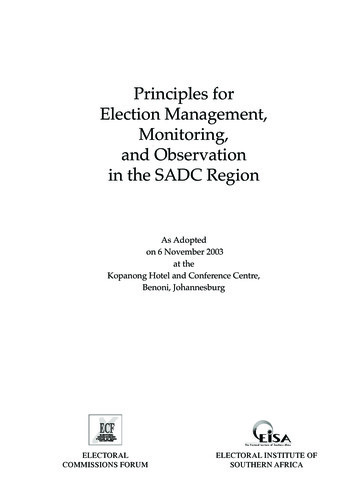
Transcription
BASIC PRINCIPLES OF MONITORINGAND EVALUATION
CONTENT1. MONITORING AND EVALUATION: DEFINITIONS2. THEORY OF CHANGE3. PERFORMANCE MANAGEMENT SYSTEMS ANDPERFORMANCE MEASUREMENT4. PERFORMANCE INDICATORS4.1 Process (implementation) indicators4.2 Process (implementation) indicators4.3 Progression indicators (labour market attachment)5. TARGETS, BASELINE AND DATA SOURCES6. MEASURING RESULTSBasic principles of monitoring and evaluationi
1. MONITORING AND EVALUATION:DEFINITIONSYouth employment programmes, like any other type of publicpolicy intervention, are designed to change the current situation of thetarget group and achieve specific results, like increasing employment orreducing unemployment. The key policy question is whether the plannedresults (outcomes) were actually achieved. Often, in fact, the attention ofpolicy-makers and programme managers is focused on inputs (e.g. thehuman and financial resources used to deliver a programme) and outputs(e.g. number of participants), rather than on whether the programme isachieving its intended outcomes (e.g. participants employed or with theskills needed to get productive jobs).Monitoring and evaluation are the processes that allow policymakers and programme managers to assess: how an intervention evolvesover time (monitoring); how effectively a programme was implementedand whether there are gaps between the planned and achieved results(evaluation); and whether the changes in well-being are due to theprogramme and to the programme alone (impact evaluation).Monitoring is a continuous process of collecting and analysinginformation about a programme, and comparing actual against plannedresults in order to judge how well the intervention is being implemented. Ituses the data generated by the programme itself (characteristics ofindividual participants, enrolment and attendance, end of programmesituation of beneficiaries and costs of the programme) and it makescomparisons across individuals, types of programmes and geographicallocations. The existence of a reliable monitoring system is essential forevaluation.Evaluation is a process that systematically and objectivelyassesses all the elements of a programme (e.g. design, implementationand results achieved) to determine its overall worth or significance. Theobjective is to provide credible information for decision-makers to identifyways to achieve more of the desired results. Broadly speaking, there aretwo main types of evaluation: Performance evaluations focus on the quality of service deliveryand the outcomes (results) achieved by a programme. Theytypically cover short-term and medium-term outcomes(e.g. student achievement levels, or the number of welfarerecipients who move into full-time work). They are carried out onthe basis of information regularly collected through the programmemonitoring system. Performance evaluation is broader thanmonitoring. It attempts to determine whether the progressachieved is the result of the intervention, or whether anotherexplanation is responsible for the observed changes. Impact evaluations look for changes in outcomes that can bedirectly attributed to the programme being evaluated. Theyestimate what would have occurred had beneficiaries notparticipated in the programme. The determination of causalitybetween the programme and a specific outcome is the key featurethat distinguishes impact evaluation from any other type ofassessment.Basic principles of monitoring and evaluation1
Monitoring and evaluation usually include information on the cost ofthe programme being monitored or evaluated. This allows judging thebenefits of a programme against its costs and identifying whichintervention has the highest rate of return. Two tools are commonlyused. A cost-benefit analysis estimates the total benefit of aprogramme compared to its total costs. This type of analysis isnormally used ex-ante, to decide among different programmeoptions. The main difficulty is to assign a monetary value to“intangible” benefits. For example, the main benefit of a youthemployment programme is the increase of employment andthe earning opportunities for participants. These are tangiblebenefits to which a monetary value can be assigned.However, having a job also increase people’s self-esteem,which is more difficult to express in monetary terms as it hasdifferent values for different persons. A cost-effectiveness analysis compares the costs of two ormore programmes in yielding the same outcome. Take forexample a wage subsidy and a public work programme. Eachhas the objective to place young people into jobs, but thewage subsidy does so at the cost of 500 per individualemployed, while the second costs 800. In cost-effectivenessterms, the wage subsidy performs better than the public workscheme.2Basic principles of monitoring and evaluation
2. THEORY OF CHANGEA theory of change describes how an intervention will deliver theplanned results. A causal/result chain (or logical framework) outlines howthe sequence of inputs, activities and outputs of a programme will attainspecific outcomes (objectives). This in turn will contribute to theachievement of the overall aim. A causal chain maps: (i) inputs (financial,human and other resources); (ii) activities (actions or work performed totranslate inputs into outputs); (iii) outputs (goods produced and servicesdelivered); (iv) outcomes (use of outputs by the target groups); and(v) aim (or final, long-term outcome of the intervention).Figure 1. Results get and staffActiontaken/workperformed totransforminputs intooutputsTangible goodsor services theprogrammeproduces ordeliversResults likelyto be achievedwhenbeneficiariesuse outputsFinalprogrammegoals, typicallyachieved in thelong-termImplementationResultsIn the result chain above, the monitoring system wouldcontinuously track: (i) the resources invested in/used by the programme;(ii) the implementation of activities in the planned timeframe; and (iii) thedelivery of goods and services. A performance evaluation would, at aspecific point of time, judge the inputs-outputs relationship and theimmediate outcomes. An impact evaluation would provide evidence onwhether the changes observed were caused by the intervention and bythis alone.Basic principles of monitoring and evaluation3
3. PERFORMANCE MANAGEMENTSYSTEMS AND PERFORMANCEMEASUREMENTPerformance management (or results-based management) is astrategy designed to achieve changes in the way organizations operate,with improving performance (better results) at the core of the system.Performance measurement (performance monitoring) is concernedmore narrowly with the production of information on performance. Itfocuses on defining objectives, developing indicators, and collecting andanalysing data on results. Results-based management systems typicallycomprise seven stages:Strategic planningPerformance measurementRESULTS-BASED MANAGEMENTFigure 2 Steps of performance management systems1.2.3.4.5.6.7.Formulating objectives: identifying in clear, measurable termsthe results being sought and developing a conceptual frameworkfor how the results will be achieved.Identifying indicators: for each objective, specifying exactlywhat is to be measured along a scale or dimension.Setting targets: for each indicator, specifying the expected levelof results to be achieved by specific dates, which will be used tojudge performance.Monitoring results: developing performance-monitoring systemsthat regularly collect data on the results achieved.Reviewing and reporting results: comparing actual resultsagainst the targets (or other criteria for judging performance).Integrating evaluations: conducting evaluations to gatherinformation not available through performance monitoringsystems.Using performance information: using information frommonitoring and evaluation for organizational learning, decisionmaking and accountability.The setting up a performance monitoring system for youthemployment programmes, therefore, requires: clarifying programmeobjectives; identifying performance indicators; setting the baseline andtargets, monitoring results, and reporting.In many instances, the objectives of a youth employmentprogramme are implied rather than expressly stated. In such cases, thefirst task of performance monitoring is to articulate what the programmeintends to achieve in measurable terms. Without clear objectives, in fact, itbecomes difficult to choose the most appropriate measures (indicators)and express the programme targets.Basic principles of monitoring and evaluation4
4. PERFORMANCE INDICATORSPerformance indicators are concise quantitative and qualitativemeasures of programme performance that can be easily tracked on aregular basis. Quantitative indicators measure changes in a specificvalue (number, mean or median) and a percentage. Qualitativeindicators provide insights into changes in attitudes, beliefs, motives andbehaviours of individuals. Although important, information on theseindicators is more time-consuming to collect, measure and analyse,especially in the early stages of programme implementation.Box .1. Tips for the development of indicatorsRelevance. Indicators should be relevant to the needs of the user and to the purpose of monitoring. They should be able to clearlyindicate to the user whether progress is being made (or not) in addressing the problems identified.Disaggregation. Data should be disaggregated according to what is to be measured. For example, for individuals the basicdisaggregation is by sex, age group, level of education and other personal characteristics useful to understanding how theprogramme functions. For services and/or programmes the disaggregation is normally done by type of service/programme.Comprehensibility. Indicators should be easy to use and understand and data for their calculation relatively simple to collect.Clarity of definition. A vaguely defined indicator will be open to several interpretations, and may be measured in different ways atdifferent times and places. It is useful in this regard to include the source of data to be used and calculation examples/methods. Forexample, the indicator “employment of participants at follow-up” will require: (i) specification of what constitutes employment (workfor at least one hour for pay, profit or in kind in the 10 days prior to the measurement); (ii) a definition of participants (e.g. those whoattended at least 50 per cent of the programme); and (iii) a follow-up timeframe (six months after the completion of the programme).Care must also be taken in defining the standard or benchmark of comparison. For example, in examining the status of youngpeople, what constitutes the norm – the situation of youth in a particular region or at national level?The number chosen should be small. There are no hard and fast rules to determine the appropriate number of indicators.However, a rule of thumb is that users should avoid two temptations: information overload and over-aggregation (i.e. too much dataand designing a composite index based on aggregation and weighting schemes which may conceal important information). Acommon mistake is to over-engineer a monitoring system (e.g. the collection of data for hundreds of indicators, most of which arenot used). In the field of employment programmes, senior officials tend to make use of high-level strategic indicators such asoutputs and outcomes. Line managers and their staff, conversely, focus on operational indicators that target processes andservices.Specificity. The selection of indicators should reflect those problems that the youth employment programme intends to address.For example, a programme aimed at providing work experience to early school leavers needs to incorporate indicators on coverage(how many among all school leavers participate in the programme), type of enterprises where the work experience takes place andthe occupation, and number of beneficiaries that obtain a job afterwards by individual characteristics (e.g. sex, educationalattainment, household status and so on).Cost. There is a trade off between indicators and the cost of collecting data for their measurement. If the collection of databecomes too expensive and time consuming, the indicator may ultimately lose its relevance.Technical soundness. Data should be reliable. The user should be informed about how the indicators were constructed and thesources used. A short discussion should be provided about their meaning, interpretation, and, most importantly, their limitations.Indicators must be available on a timely basis, especially if they are to provide feedback during programme implementation.Forward-looking. A well-designed system of indicators must not be restricted to conveying information about current concerns.Indicators must also measure trends over time.Adaptability. Indicators should be readily adaptable to use in different regions and circumstances.Source: adapted from Canadian International Development Agency (CIDA), 1997. Guide to Gender-Sensitive Indicators(Ottawa, CIDA).5Basic principles of monitoring and evaluation
When choosing performance indicators, it is important toidentify indicators at all levels of the results chain, and not just at thelevel of outcomes. Information on process is useful for documentingprogramme implementation over time and explaining differencesacross programme sites. Information on individual participants (e.g.sex, age group, national origin, medical condition, educationalattainment, length of unemployment spells and so on) allows users tojudge compliance with targeting criteria. Some examples of the mostcommon implementation indicators are shown in the Table 1 below.4.1 PROCESS(IMPLEMENTATION)INDICATORSTable.1. Example of common process (implementation) indicators (measurement anddisaggregation)Process indicators1 Composition of entrants,participants, completers *Calculation methodNumber of entrants in period t*100 --------------------------Total number of entrants in period tDisaggregation by type of programme by characteristics of individualsProgramme: training, subsidy, selfemployment, etc.Individuals by sex, age group, educationlevel, unemployment duration, type ofdisadvantage, prior occupation/workexperience2 Stock variation of entrants,participants, completersNumber of entrants in period tAs above --------------------------Number of entrants in period t-13 Inflow of entrants (orparticipants)Number of new entrants in period tAs above --------------------------Stock of entrants end of period t-14 Degree of coverage of targetpopulation (entrants,participants, completers)5 ImplementationNumber of programme entrants*100As above --------------------------Total targeted populationNumber of implemented actionsAs above -------------------------Number of planned actions6 Average cost per entrant,participant, completerTotal cost of programmeBy programme --------------------------Total number of entrantsNote: * Entrants are all individuals who start a specific programme. Participants are all individuals who entered and attended the programme for a minimumperiod of time (usually determined by the rules of the programme as the minimum period required to produce changes, for example 50 per cent of theprogramme duration). Completers are those who completed the whole programme. Dropouts, usually, are those who left the programme before a minimumperiod of attendance established by the rules of the programme (e.g. the difference between entrants and participants).Basic principles of monitoring and evaluation6
The indicator in the first row, for example, serves to determinewhether the targeting rules of the programme are being complied with. Forinstance, in a youth employment programme targeting individuals withless than primary education, the share of entrants by this level ofeducation over the total will determine if eligibility rules are being followedand allow tracking of sites with the best/worst compliance.The indicators in the second and third rows serve to measure theevolution of the programme’s intake. It is normal, in fact, to see increasesin intake as the programme matures. The time t may be any time interval(yearly, quarterly or monthly). The indicator in the fourth row serves tomeasure the overall coverage of the programme. Depending on its scope,the denominator can be the total number of youth (in a country, region,province or town) or only those who have certain characteristics (e.g. onlythose who are unemployed, workers in the informal economy, individualswith a low level of education). The indicator in the fifth row serves tomeasure the pace of implementation compared to the initial plan, whilethe indicator in the last row is used to calculate overall costs.4.2 PROCESS(IMPLEMENTATION)INDICATORSSince the overarching objective of youth employmentprogrammes is to help young people get a job, the most significantoutcome indicators are: (i) the gross placement (employment) rate byindividual characteristics and type of programme; (ii) average cost peryoung person placed; and (iii) the level of earnings of youth participantsemployed. The more disaggregated the data, the better, as this allowscomparison across individuals, programmes and geographical locations.Calculation methods and disaggregation are shown in Table 2 below.Table 3: Outcome indicators (measurement and disaggregation)Outcomeindicators1Gross placement rates(individuals)CalculationmethodNumber ofplacements*100 ----------------------Total numberparticipants(including dropouts)Disaggregation by type of programme by characteristics of individuals by type of jobProgramme: training, subsidy, self-employment,public work schemeIndividuals by sex, age group, education level,unemployment duration, type of disadvantage,prior occupation/work experienceJobs by economic sector and size of theenterprise, occupation, contract type andcontract duration7Basic principles of monitoring and evaluation
2 EarningsNumber of individualsplaced in a job and earning(hourly) wages over theminimum*100 by type of programme by characteristics of individuals by type of jobs ----------------------Number of placements3 Cost per placementTotal cost by type of programme ----------------------Number of placementsThe above-mentioned disaggregation also allows data users tojudge the “quality” of the results achieved. The use of total placementas an indicator of performance, in fact, has two main shortcomings.The first is the likely prevalence of short-term employment and thelikelihood that beneficiaries re-enter unemployment soon after the endof the programme. The second is the lack of distinction between “easyto-place” youth (who would eventually get a job also without theprogramme) and “disadvantaged” youth (who are likely to experiencelong spells of unemployment if they are not helped). The first issueresults in “gaming” behaviour, for example, administrators may betempted to “cheat” the system by focusing on short-term placement(with no attention to quality) to achieve programme targets. The secondgives rise to “creaming” (or cream-skimming), namely the selection forprogramme participation of those youth most likely to succeed, ascompared to those who most need the programme.The disaggregation proposed in Table 2 corrects theseshortcomings by requiring collection of information on thecharacteristics of individuals employed and the type of jobs theyperform. Calculation of hourly wages helps to measure the welfaregains more accurately than total earnings, as young workers may havehigher earnings only because they work longer hours.Cost is another important measure: it allows users to decidewhether a programme is cost-effective (e.g. whether the rate of returnin terms of placement justifies the resources invested).1 Usually, theoverall costs of a programme are compared to those of otherprogrammes with similar obje
Performance management (or results-based management) is a strategy designed to achieve changes in the way organizations operate, with improving performance (better results) at the core of the system. Performance measurement (performance monitoring) is concerned more narrow











